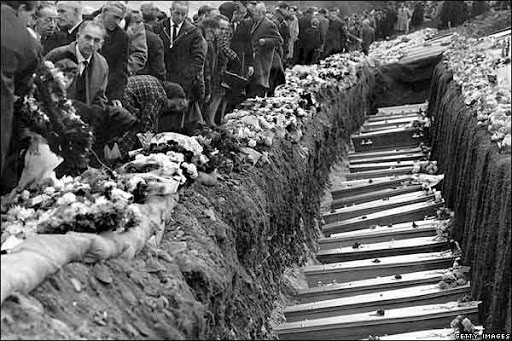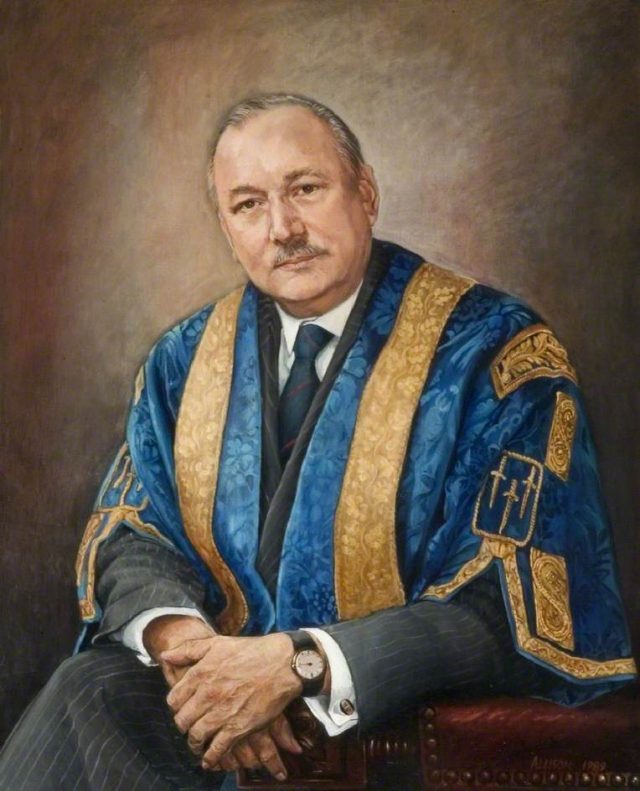20 October 2016
The Aberfan tragedy – what happened next?
Posted by Dave Petley

The dreadful reality of the Aberfan tragedy (via Getty Images)
The Aberfan tragedy – what happened next?
The National Coal Board and the tribunal
In the stunned aftermath of the Aberfan tragedy, a sense prevailed that there must never be a repeat. The Official Tribunal worked efficiently, and the final report pulls no punches about individual and corporate responsibility, even if this did not translate into criminal prosecutions. As I have noted previously, a remarkable aspect of the Tribunal is the belligerence of the National Coal Board – even more remarkable for the fact that it was a government body – to the extent that the Tribunal report includes a section entitled “The attitude of the National Coal Board“. The section on liability starts with the following observation:
Blameworthiness for the disaster of 1966 remained an issue strongly contested by the National Coal Board for the greater part of the Tribunal’s sittings
This is indeed the case, although ultimately they did concede responsibility, and the Tribunal report does not hide its distaste for the way that the National Coal Board conducted themselves. Given the facts of the case, as I have outlined in my previous two posts, how could the National Coal Board have argued that they were not to blame?
At the start of the Tribunal, the National Coal Board claimed that:
“The Board’s view is that the disaster was due to a coincidence of a set of geological factors, each of which in itself is not exceptional but which collectively created a particularly critical geological environment.”
The Tribunal report notes that:
The Tribunal is in no doubt that this was the starting-point of an attempt, persisted in for many weeks by the National Coal Board, to persuade acceptance of the view that the concatenation of geological features on Merthyr Mountain was such as could not reasonably have been expected to exist. The observation quoted at first sounded impressive, but it turned out that it explained nothing.

Lord Robens, painted by Jane Allison
.
The Tribunal is particularly critical, and rightly so, of Lord Robens, the Chairman of the National Coal Board, who gave evidence to the Tribunal investigation the Aberfan tragedy. The report notes that within two days of the disaster Lord Robens had made the following comment to a television reporter:
“It was impossible to know that there was a spring in the heart of this tip which was turning the centre of the mountain into sludge”.
This was of course clearly not the case – the Ordnance Survey maps clearly showed these springs. Despite this, the Tribunal notes that this remained the position of the National Coal Board until Day 65, and even then they only changed their position under cross-examination. Late in the day, the Tribunal decided to give Lord Robens the opportunity to give evidence. Remarkably, he initially maintained his position that the hazard could not have been known, and thus that the Aberfan tragedy could not have been anticipated:
I think it would have been apparent to anybody that what I was saying is that the people on the site did not know, and it would have been impossible for them to know, because we had failed as a Board to provide the necessary regulation [sic] to enable them to know…
The criticism of this position by the Tribunal is scathing:
That this interpretation was placed on his words by no other National Coal Board witness who was asked to deal with them and, furthermore, had not occurred even to learned counsel appearing for the National Coal Board, emerged clearly in the course of the Inquiry. Nor did we accept it for one moment. Ultimately, even counsel for the National Coal Board invited the Tribunal to ignore it. By his words, read in their entirety, Lord Robens had conveyed to no-one that he was accepting that any measure of blame lay with the National Coal Board.
Hidden in this statement is a remarkable observation:
Ultimately, even counsel for the National Coal Board invited the Tribunal to ignore it.
Thus, even the lawyers for the National Coal Board directed the Tribunal to consider Lord Robens to be an unreliable witness. The Tribunal also noted that during his cross-examination, Lord Robens eventually conceded that the National Coal Board had determined that the instability was foreseeable, even before the Tribunal itself began. The report notes:
If the position really was as Lord Robens said (viz, that before ever the Inquiry opened the National Coal Board realised that the instability of Tip 7 was reasonably detectable before the disaster) it followed that a vast amount of time had been unnecessarily spent on issues which were directed at establishing that very point.
Recommendations of the Tribunal
The Tribunal made a number of recommendations. The first concerned the site itself – the Tribunal of course recommended that the site be made safe, but noted the objections by the National Coal Board to the ideal solution, removal of the tips altogether. Thus, the Tribunal recommended recontouring and drainage. I return to this below.
The Tribunal also made clear recommendations about the assessment of sites to be used for tipping, and about management of the tips themselves, primarily through a National Tip Safety Committee, with properly qualified experts. The Tribunal notes the importance of proper governance, responsibility and accountability. This was enshrined in law in 1969. That there has been no repeat of Aberfan in the UK suggests that these recommendations were effective.
The scandal of the unquestionably unlawful extraction of money from the Disaster Fund to pay for the removal of the tips
In the aftermath of the Aberfan tragedy, the public donated £1,606,000 in almost 90,000 individual contributions to a Disaster Fund. In 1966 this was a vast sum of money (wikipedia estimates that this is £27.8 million by 2015 values). After the disaster, a decision was taken to remove the tips above Aberfan, although the National Coal Board maintained a view that as they were not dangerous they had no responsibility for the costs of this operation. Under “intolerable pressure” from the Labour government, but in secret, the trustees of the Disaster Fund agreed to provide £150,000 to pay for the removal. This deed did not become fully clear until 1997; subsequently the regulator of charities in the UK, the Charities Commission, have ruled that this was “unquestionably unlawful”.
In 1997, the Labour Government of Tony Blair repaid the £150,000 to the Disaster Fund, but without any interest. Whilst this in some ways repairs some of the damage, that interest was not paid means that the Disaster Fund made, in effect, an interest-free long term loan to the National Coal Board. This remains deeply unjust.


 Dave Petley is the Vice-Chancellor of the University of Hull in the United Kingdom. His blog provides commentary and analysis of landslide events occurring worldwide, including the landslides themselves, latest research, and conferences and meetings.
Dave Petley is the Vice-Chancellor of the University of Hull in the United Kingdom. His blog provides commentary and analysis of landslide events occurring worldwide, including the landslides themselves, latest research, and conferences and meetings.